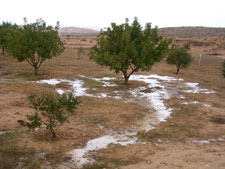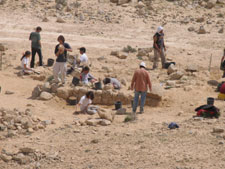


 |
About Mnemotrix Systems, Inc. (USA) |
 |
Mnemotrix Israel, Ltd. Home |
 |
GIS Support |
 |
Sub-surface Mapping and Analysis |
 |
Cultural Resource Management / Social Dynamics & Economics |
 |
ADASR Project |
 |
Focus on Avdat |
 |
Who We Are & Board of Advisors |
 |
CRM Organizations |
 |
Explore the Holy Land with us |
 |
Request Form |
Cultural Resource Management (CRM) Services Background:
Many years back while living in the USA we helped to build an important AI (Artificial Intelligence) system for the US Dept of Agriculture in association with Clemson University called LISA. It stood for "Low Input Sustainable Agriculture." Since that time the acronym has become a standard term in agricultural research.
Reviving Ancient Agricultural Terraces
in the DesertA few years ago while doing pro bono Ground Penetrating Radar (GPR) work here in Israel I met and became involved with a small group of Israeli professors who asked me to assist them in resolving some very tough computing tasks involving the correlation of field research data within a Geographical Information System (GIS) environment. The complexity of the problem demanded a new set of computing solutions which no one here in Israel could provide. Upon further study I determined that their requirements also exceeded the capability of most existing computing applications. So, we went ahead and built a new dynamic technology for them to use to help unlock the secrets to how Israel's ancient agricultural systems worked ages ago. Let me explain this further:
During the Hellenic and Byzantine Periods, the Negev Desert was filled with hundreds if not thousands of small and large agricultural sites where grapes were cultivated and harvested and made into wine. The remains of these agricultural sites dot the landscape along with the remains of the cities where wine was made such as at Avdat. The large wine presses at Avdat and Shivta (to name a few) are testimony to the agriculture of the region at the time.
Community Involvement in Local Archaeology at Avdat How these low input systems worked to create so much produce has remained a mystery till now. Over the last 25 years, Dr. Moti Haiman of the Israel Antiquities Authority and recently under the auspices of Bar Ilan University, with funding and support from a number of sources including Mnemotrix Israel Ltd, has plotted these sites onto maps in an attempt to understand how they worked as a network and to learn how water was harvested and utilized. These systems represented a low input sustainable agriculture in an arid and semi arid region.
With the help of Mnemotrix Israel, Ltd., using our Intelligent Agent Software solutions, we were able to merge the GIS (Geographical Information System) data about each site including their exact GPS (Global Positioning Satellite) coordinates into a computer environment where all the sites could be studied as one large network. With this insight and also with accompanying GPR (Ground Penetrating Radar) studies from Mnemotrix Israel Ltd. of the hillsides and rain runoff areas, a fuller understanding was achieved.
Concurrent to this work, Dr. Haiman in association with Dr. Amos Hadas, was able to locate a genus of grape which was most probably the same or a similar type that was planted in ancient times to be best suited for growth in this rugged low input arid environment. The result is that we are now able to grow a grape and make a wine which is most historically accurate to both the Byzantine and Hellenic Periods of Israel's past. This is historical conservation and experimental agriculture at its best.
What makes this project important is that we have used advanced technology to study the past and we can now grow and harvest a grape and make a wine product which can be sold as a boutique agricultural heritage. But even more importantly it can be done in a way which makes use of only the naturally occurring water and earth resources. This can represent a paradigm shift in agriculture globally, and packaged accordingly may be marketed and sold as a LISA (Low Input Sustainable Agriculture) science throughout the world.
Notwithstanding the opportunity to build a new wine and possibly other agricultural industry in the arid Negev region, the gains from further study and codification of these insights with the technology that was created to make these discoveries may represent a whole new economic base from which Israel and Israeli business can grow.
There is a website which explains much of how we did this and with whom we have worked at: http://www.mnemotrix.com/adasr .
Goals:
Our goals for this project at the present are quite literally to continue to revive the old agricultural sites, and breathe new life into them again, in keeping with the original project name ADASR: Ancient Desert Agricultural Systems Revived. More specifically this is where we are headed right now:
Cultural Resource Management Projects:
- Expand the access and scope of our ADASR Smart Geo-Referencing computer system.
- Maintain a Smart Geo-Referencing Database of the ancient sites and the newly revived fields, as well as for the individual plantings, so as to achieve optimal production management. This database can also be used to study and manage other sites throughout the world in a consulting and licensing capacity. There are many similar situations demanding solutions throughout Africa, Asia and Australia and in many places in the American South West. (Click here to see Israel ADASR Geo-Referenced Database).
- Develop collaborations with US, European, Israeli, and other Middle Eastern universities, groups, and organizations to share data and technology, and to work in concourse on related issues involving the social dynamics of the indigenous semi-nomadic Bedouin peoples of the region.
This project is an example of the way in which Mnemotrix Israel, Ltd. is working in the rapidly growing field of Cultural Resource Management (CRM). This field allows us to use technology to engineer the human compact between the ancient and modern world.
Contact:
If you are interested in participating in this or other exciting projects please contact us here in Israel.


